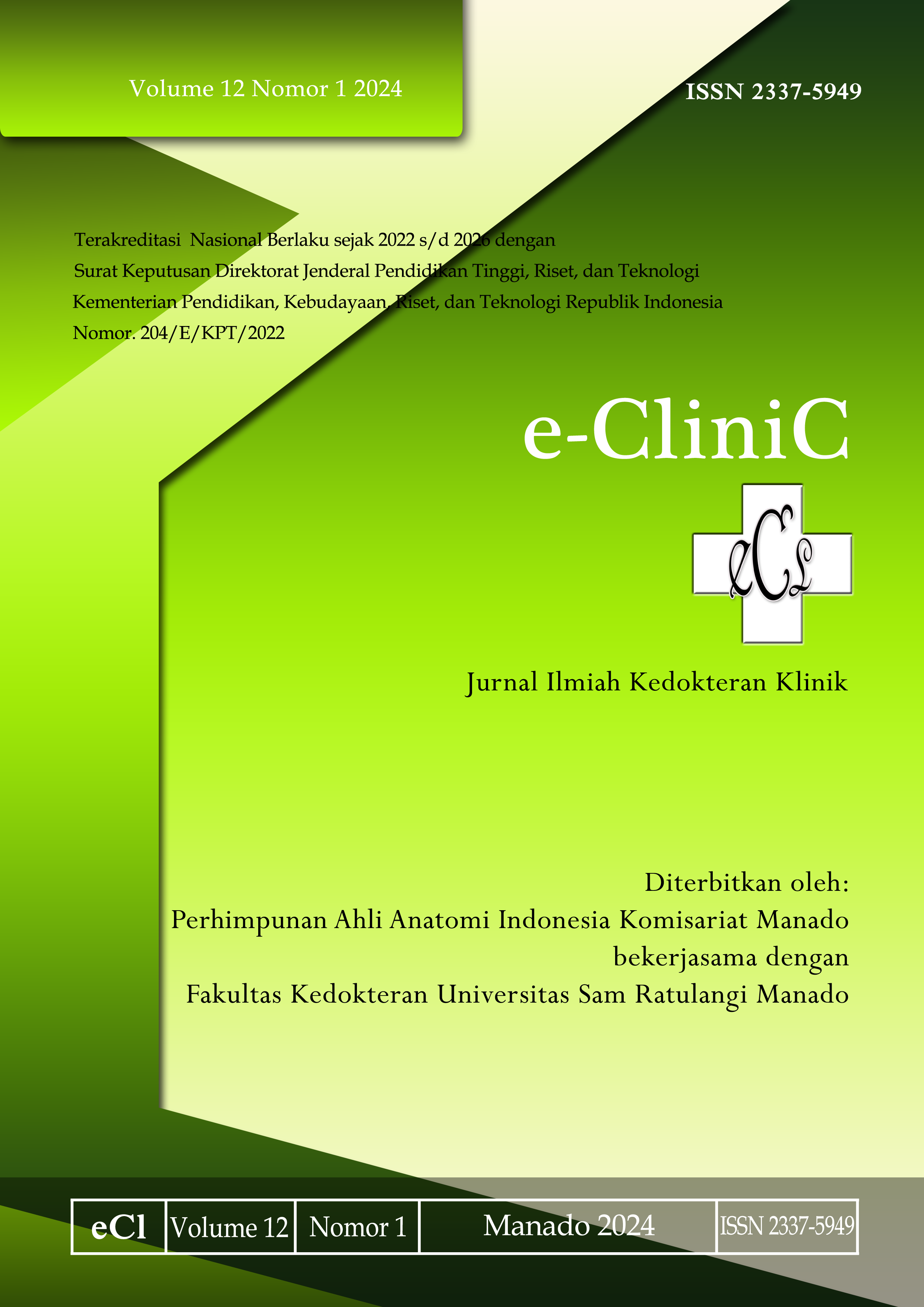Pengaruh Masker terhadap Akne Vulgaris (Maskne)
DOI:
https://doi.org/10.35790/ecl.v12i1.45242Abstract
Abstract: During the Covid-19 pandemic, Indonesian people were required to wear masks during their daily activities that caused increased duration of wearing masks associated with increased incidence of acne vulgaris. This study aimed to determine the relationship between the use of masks and acne vulgaris (maskne). This was a literature review study. Sources of information were obtained from journals and research articles in Pubmed, Google Scholar, and the British Journal of Dermatology which discussed the relationship between mask use and maskne. The results obtained 10 literatures with a cross sectional design that fulfilled the inclusion and exclusion criteria. Review of the 10 literatures resulted in a relationship between the use of masks and the occurrence of mask-induced acne (maskne). The distribution of respondents based on the incidence of maskne was most common in women and the type of mask most often used was the surgical mask. The majority of respondents replaced their masks twice daily with duration of use for 4-8 hours. In conclusion, there is a relationship between the use of masks and the occurrence of maskne.
Keywords: mask; acne vulgaris; maskne
Abstrak: Selama pandemi Covid-19 masyarakat Indonesia diwajibkan menggunakan masker selama melakukan kegiatan sehari-hari sehingga durasi penggunaan masker meningkat dan meningkatnya kejadian akne vulgaris. Penelitian ini bertujuan untuk mengetahui hubungan penggunaan masker dengan akne vulgaris melalui suatu literature review. Sumber informasi didapatkan melalui jurnal maupun artikel penelitian pada Pubmed, Google Scholar, dan British Journal of Dermatology yang membahas mengenai hubungan penggunaan masker dengan mask-induced acne (maskne). Hasil penelitian mendapatkan 10 literatur yang sesuai kriteria inklusi dan eksklusi dengan desain potong lintang. Kajian 10 literatur ini mendapatkan adanya hubungan penggunaan masker dengan kejadian maskne. Sebaran jumlah responden berdasarkan kejadian maskne paling banyak pada perempuan dan jenis masker yang paling sering digunakan ialah masker bedah. Didapatkan paling banyak mengganti masker dua kali sehari dengan penggunaan selama 4-8 jam. Simpulan penelitian ini ialah terdapat hubungan penggunaan masker dengan kejadian maskne.
Kata kunci: penggunaan masker; akne vulgaris; maskne
References
Kemenkes Rl. Situasi Terkini Perkembangan Coronavirus Disease (COVID-19). Jakarta: Kemenkes; 2021.
SATGAS. Satuan Tugas Penangan COVID-19: Data Sebaran 2020. 2020.
Kementerian Kesehatan RI. Direktorat Pencegahan dan Pengendalian Penyakit: Pedoman dan Pencegahan Pengendalian Coronavirus Disease (COVID-19). 2020.
Gomolin A, Celin A. Maskne: exacerbation or eruption of acne during the COVID-19 Pandemic. Natl Soc Cutan Med. 2020;4(5):438–9.
Gu L, Xiang L, Lipner SR. Analysis of availability of online dermatology appointments during the COVID-19 pandemic. J Am Acad Dermatol. 2021;84(2):517–20.
Damiani G, Gironi LC, Grada A, Kridin K, Finelli R, Buja A, et al. COVID-19 related masks increase severity of both acne (maskne) and rosacea (mask rosacea): multi-center, real-life, telemedical, and observational prospective study. Dermatol Ther. 2021;34(2):2–6.
Doğan Eİ, Kaya F. Dermatological findings in patients admitting to dermatology clinic after using face masks during Covid-19 pandemia: a new health problem. Dermatol Ther. 2021;34(3):1–7.
Zuo Y, Hua W, Luo Y, Li L. Skin reactions of N95 masks and medial masks among health-care personnel: A self-report questionnaire survey in China. Contact Dermatitis. 2020;83(2):145–7.
Aravamuthan R, Arumugam S. Clinico-epidemiological study of mask induced acne due to increased mask use among health care workers during COVID pandemic in a tertiary care institute. Int J Res Dermatology. 2020;7(1):48.
Altun E, Topaloglu Demir F. Occupational facial dermatoses related to mask use in healthcare professionals. J Cosmet Dermatol. 2022;21(6):2535–41.
Yaqoob S, Saleem A, Jarullah FA, Asif A, Essar MY, Emad S. Association of acne with face mask in healthcare workers amidst the covid-19 outbreak in karachi, Pakistan. Clin Cosmet Investig Dermatol. 2021;14(August):1427–33.
Choi SY, Hong JY, Kim HJ, Lee GY, Cheong SH, Jung HJ, et al. Mask-induced dermatoses during the COVID-19 pandemic: a questionnaire-based study in 12 Korean hospitals. Clin Exp Dermatol. 2021;46(8):1504–10.
Marianingrum D, Purwati K, Andini AS. Pengaruh jenis masker terhadap kejadian mask-acne (Maskne) di era pandemi Covid-19 pada perawat di RSUD Pesanggrahan Jakarta Selatan. Zona Kedokt. 2021;11(3):63–75.
Damayanti L. Karakteristik Akne akibat masker (maskne) pada petugas kesehatan di Rumah Sakit Dustira Cimahi. Med Kartika J Kedokt dan Kesehat. 2021;4(5):543–52.
Barus A, Putri AU. Hubungan perilaku penggunaan masker dengan kejadian mask induce acne pada mahasiswa Fakultas Kedokteran Universitas Muhammadiyah Sumatera Utara. J Ilm Simantek. 2022;6(4):55–61.
Falodun O, Medugu N, Sabir L, Jibril I, Oyakhire N, Adekeye A. An epidemiological study on face masks and acne in a Nigerian population. PLoS One [Internet]. 2022;17(5 May):1–9. Available from: http://dx.doi.org/10.1371/journal.pone.0268224
Downloads
Published
How to Cite
Issue
Section
License
Copyright (c) 2023 Khoirunnisa A. Mokoagow, Marlyn. G. Kapantow, Herry E. J. Pandaleke

This work is licensed under a Creative Commons Attribution-NonCommercial 4.0 International License.
COPYRIGHT
Authors who publish with this journal agree to the following terms:
Authors hold their copyright and grant this journal the privilege of first publication, with the work simultaneously licensed under a Creative Commons Attribution License that permits others to impart the work with an acknowledgment of the work's origin and initial publication by this journal.
Authors can enter into separate or additional contractual arrangements for the non-exclusive distribution of the journal's published version of the work (for example, post it to an institutional repository or publish it in a book), with an acknowledgment of its underlying publication in this journal.
Authors are permitted and encouraged to post their work online (for example, in institutional repositories or on their website) as it can lead to productive exchanges, as well as earlier and greater citation of the published work (See The Effect of Open Access).







